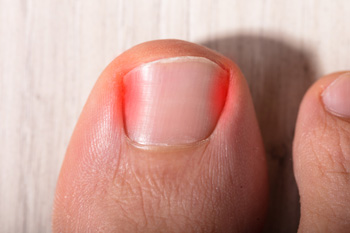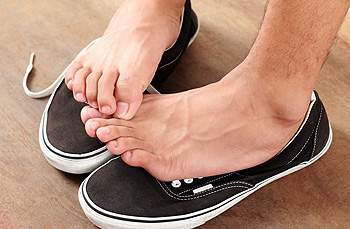Blog
Possible Foot Concerns with Aging
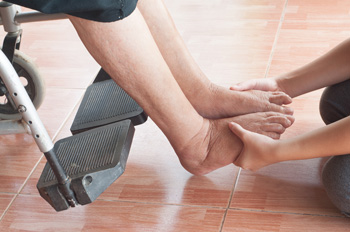 Because each foot consists of several bones, ligaments, and tendons provide stability to the body, there are conditions that gradually develop and affect the feet. These can include nail infections, gout, a neuroma, bunions, corns, hammertoes, and heel pain. Because of this, many older patients are concerned about foot disorders and the pain that may be associated with them. It may be difficult for older people to maintain balance which may lead to falling. Additionally, it can be challenging to climb stairs and exercise which can lead to weakness and muscle pain. If you are experiencing any type of foot pain, it is strongly advised that you are under the care of a podiatrist who can diagnose and offer correct treatment solutions.
Because each foot consists of several bones, ligaments, and tendons provide stability to the body, there are conditions that gradually develop and affect the feet. These can include nail infections, gout, a neuroma, bunions, corns, hammertoes, and heel pain. Because of this, many older patients are concerned about foot disorders and the pain that may be associated with them. It may be difficult for older people to maintain balance which may lead to falling. Additionally, it can be challenging to climb stairs and exercise which can lead to weakness and muscle pain. If you are experiencing any type of foot pain, it is strongly advised that you are under the care of a podiatrist who can diagnose and offer correct treatment solutions.
If you need your feet checked, contact one of our podiatrists of James Kutchback, DPM, CWS-P. Our doctors will attend to all of your foot and ankle needs and provide you with quality treatment.
Geriatrics and Podiatry
When people age, some common issues that may occur are bone density loss, dry skin, poor circulation, and rough brittle nails. These issues may also affect your foot health if the necessary steps are not taken to alleviate the problems.
It is important to take care of your feet because feet that are injured or diseased can affect your overall health. Having painful feet hinders your ability to do daily activities or may decrease your willingness to do the things that you need to do.
Visiting Your Geriatrician
As we age, health problems become more likely, so it is essential to visit your doctor for check-ups to ensure that you are doing the best you can to take care of your health. It is recommended to check your feet frequently for any possible cuts, bruises, swelling, corns or any other irregularities.
Taking Care of Elderly Feet
Cracked or dry feet can be treated by applying moisturizer often. It is also important not to wear old socks because the older the sock is, the higher the possibility there will be that there is bacteria there. Wear fresh socks and make sure they fit properly.
Proper foot health means that you can have a more active lifestyle and you will not be bogged down by pain. Foot health also leads to good circulation, which is paramount for overall health.
If you have any questions, please feel free to contact our offices located in The Woodlands and Woodville, TX . We offer the newest diagnostic and treatment technologies for all your foot care needs.
Why Is the Outside of My Ankle Swollen?
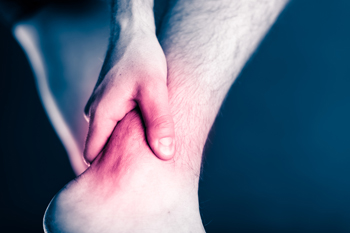 The outer part of your ankle may be swollen due to an injury or because of an underlying medical condition. Ankle injuries such as sprains, fractures, and tendinopathies can make the ankle swell. Arthritis can affect any joint in the body, including the ankle joint. When the arthritic ankle joint is inflamed, it can cause the ankle to swell. You may also notice symptoms like warmth and redness around the joint and difficulty moving the ankle. Cellulitis, a skin infection, can also make the feet and lower legs swell. If you notice swelling around your ankle, it is suggested that you see a podiatrist for treatment.
The outer part of your ankle may be swollen due to an injury or because of an underlying medical condition. Ankle injuries such as sprains, fractures, and tendinopathies can make the ankle swell. Arthritis can affect any joint in the body, including the ankle joint. When the arthritic ankle joint is inflamed, it can cause the ankle to swell. You may also notice symptoms like warmth and redness around the joint and difficulty moving the ankle. Cellulitis, a skin infection, can also make the feet and lower legs swell. If you notice swelling around your ankle, it is suggested that you see a podiatrist for treatment.
Ankle pain can be caused by a number of problems and may be potentially serious. If you have ankle pain, consult with one of our podiatrists from James Kutchback, DPM, CWS-P. Our doctors will assess your condition and provide you with quality foot and ankle treatment.
Ankle pain is any condition that causes pain in the ankle. Due to the fact that the ankle consists of tendons, muscles, bones, and ligaments, ankle pain can come from a number of different conditions.
Causes
The most common causes of ankle pain include:
- Types of arthritis (rheumatoid, osteoarthritis, and gout)
- Ankle sprains
- Broken ankles
- Achilles tendonitis
- Achilles tendon rupture
- Stress fractures
- Bursitis
- Tarsal tunnel syndrome
- Plantar fasciitis
Symptoms
Symptoms of ankle injury vary based upon the condition. Pain may include general pain and discomfort, swelling, aching, redness, bruising, burning or stabbing sensations, and/or loss of sensation.
Diagnosis
Due to the wide variety of potential causes of ankle pain, podiatrists will utilize a number of different methods to properly diagnose ankle pain. This can include asking for personal and family medical histories and of any recent injuries. Further diagnosis may include sensation tests, a physical examination, and potentially x-rays or other imaging tests.
Treatment
Just as the range of causes varies widely, so do treatments. Some more common treatments are rest, ice packs, keeping pressure off the foot, orthotics and braces, medication for inflammation and pain, and surgery.
If you have any questions please feel free to contact our offices located in The Woodlands and Woodville, TX . We offer the newest diagnostic tools and technology to treat your foot and ankle needs.
Sever’s Disease May Cause Heel Pain in Children
 Sever’s disease occurs when the bones in the calves grow faster than the Achilles tendon, which connects the heel bone to the calf muscle. When this happens, the tendon begins to tighten, and the heel becomes swollen and sore. Sever’s disease often affects children between the ages of 9 and 13 who are participants in running and jumping sports such as soccer, gymnastics, baseball, basketball, and football. There is rarely swelling as a result, and most often, the heel pain is worse when running with shoes that have limited support. The pain usually goes away with rest and does not have an impact with low impact sports such as cycling and swimming. If your child complains of heel pain, you should take them to see a podiatrist for a proper examination. Upon examination, a podiatrist will be able to provide a proper diagnosis and treatment method.
Sever’s disease occurs when the bones in the calves grow faster than the Achilles tendon, which connects the heel bone to the calf muscle. When this happens, the tendon begins to tighten, and the heel becomes swollen and sore. Sever’s disease often affects children between the ages of 9 and 13 who are participants in running and jumping sports such as soccer, gymnastics, baseball, basketball, and football. There is rarely swelling as a result, and most often, the heel pain is worse when running with shoes that have limited support. The pain usually goes away with rest and does not have an impact with low impact sports such as cycling and swimming. If your child complains of heel pain, you should take them to see a podiatrist for a proper examination. Upon examination, a podiatrist will be able to provide a proper diagnosis and treatment method.
Sever's disease often occurs in children and teens. If your child is experiencing foot or ankle pain, see one of our podiatrists from James Kutchback, DPM, CWS-P. Our doctors can treat your child’s foot and ankle needs.
Sever’s Disease
Sever’s disease is also known as calcaneal apophysitis, which is a medical condition that causes heel pain I none or both feet. The disease is known to affect children between the ages of 8 and 14.
Sever’s disease occurs when part of the child’s heel known as the growth plate (calcaneal epiphysis) is attached to the Achilles tendon. This area can suffer injury when the muscles and tendons of the growing foot do not keep pace with bone growth. Therefore, the constant pain which one experiences at the back of the heel will make the child unable to put any weight on the heel. The child is then forced to walk on their toes.
Symptoms
Acute pain – Pain associated with Sever’s disease is usually felt in the heel when the child engages in physical activity such as walking, jumping and or running.
Highly active – Children who are very active are among the most susceptible in experiencing Sever’s disease, because of the stress and tension placed on their feet.
If you have any questions, please feel free to contact our offices located in The Woodlands and Woodville, TX . We offer the newest diagnostic and treatment technologies for all your foot care needs.
What Can Cause an Ingrown Toenail?
Ingrown toenails can occur from a sudden injury, genetics, or from wearing shoes that do not fit correctly. Additionally, ingrown toenails can develop if the toenails are cut improperly. The big toe is most frequently affected. Common symptoms that are often associated with this ailment include reddened skin surrounding the ingrown nail, tenderness, and pain. This is a result of the nail growing into the skin. If the area becomes infected, drainage may ooze from the sides of the nail. Some patients find it beneficial to soak their toe in warm water, as this may help to soften the affected area enough to separate the nail from the skin. It is strongly suggested that you consult with a podiatrist if you have an ingrown toenail.
Ingrown toenails may initially present themselves as a minor discomfort, but they may progress into an infection in the skin without proper treatment. For more information about ingrown toenails, contact one of our podiatrists of James Kutchback, DPM, CWS-P. Our doctors can provide the care you need to keep you pain-free and on your feet.
Ingrown Toenails
Ingrown toenails are caused when the corner or side of a toenail grows into the soft flesh surrounding it. They often result in redness, swelling, pain, and in some cases, infection. This condition typically affects the big toe and may recur if it is not treated properly.
Causes
- Improper toenail trimming
- Genetics
- Improper shoe fitting
- Injury from pedicures or nail picking
- Abnormal gait
- Poor hygiene
You are more likely to develop an ingrown toenail if you are obese, have diabetes, arthritis, or have any fungal infection in your nails. Additionally, people who have foot or toe deformities are at a higher risk of developing an ingrown toenail.
Symptoms
Some symptoms of ingrown toenails are redness, swelling, and pain. In rare cases, there may be a yellowish drainage coming from the nail.
Treatment
Ignoring an ingrown toenail can have serious complications. Infections of the nail border can progress to a deeper soft-tissue infection, which can then turn into a bone infection. You should always speak with your podiatrist if you suspect you have an ingrown toenail, especially if you have diabetes or poor circulation.
If you have any questions, please feel free to contact our offices located in The Woodlands and Woodville, TX . We offer the newest diagnostic and treatment technologies for all your foot care needs.
Treatment for Hyperhidrosis
Plantar hyperhidrosis causes excessively sweaty feet. This problem can be embarrassing, and having constantly wet feet may increase your risk of developing certain foot problems, such as blisters or athlete’s foot. Fortunately, there are many treatments available for plantar hyperhidrosis. For mild to moderate cases, using an antiperspirant is recommended. Antiperspirants can come in a variety of forms to help reduce sweating by blocking the pores from which sweat escapes. Another potential treatment is iontophoresis, which can inhibit the overactive sweat glands’ ability to produce sweat. If you have excessively sweaty feet, it is suggested that you see a podiatrist, who can help you find the right treatment for you.
If you are suffering from hyperhidrosis contact one of our podiatrists of James Kutchback, DPM, CWS-P. Our doctors can provide the care you need to attend to all of your foot and ankle needs.
Hyperhidrosis of the Feet
Hyperhidrosis is a rare disorder that can cause people to have excessive sweating of their feet. This can usually occur all on its own without rigorous activity involved. People who suffer from hyperhidrosis may also experience sweaty palms.
Although it is said that sweating is a healthy process meant to cool down the body temperature and to maintain a proper internal temperature, hyperhidrosis may prove to be a huge hindrance on a person’s everyday life.
Plantar hyperhidrosis is considered to be the main form of hyperhidrosis. Secondary hyperhidrosis can refer to sweating that occurs in areas other than the feet or hands and armpits. Often this may be a sign of it being related to another medical condition such as menopause, hyperthyroidism and even Parkinson’s disease.
In order to alleviate this condition, it is important to see your doctor so that they may prescribe the necessary medications so that you can begin to live a normal life again. If this is left untreated, it is said that it will persist throughout an individual’s life.
A last resort approach would be surgery, but it is best to speak with your doctor to find out what may be the best treatment for you.
If you have any questions, please feel free to contact our offices located in The Woodlands and Woodville, TX . We offer the newest diagnostic and treatment technologies for all your foot care needs.
What Can Cause Plantar Fasciitis?
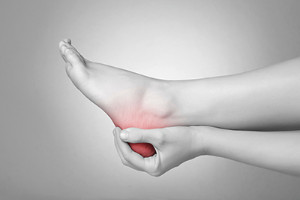 The pain from plantar fasciitis is often noticed first thing in the morning. It occurs as a result of an inflamed plantar fascia, which is the band of tissue on the sole of the foot. The purpose of the plantar fascia is to connect the toes to the heel, and straining the plantar fascia can cause it to become inflamed. This can happen from standing on hard surfaces for extended periods of time throughout the day, or from wearing shoes that do not fit correctly. Additionally, people who enjoy running and those who are overweight may be prone to developing plantar fasciitis. If you have heel pain, it is recommended that you seek the counsel of a podiatrist who can treat plantar fasciitis.
The pain from plantar fasciitis is often noticed first thing in the morning. It occurs as a result of an inflamed plantar fascia, which is the band of tissue on the sole of the foot. The purpose of the plantar fascia is to connect the toes to the heel, and straining the plantar fascia can cause it to become inflamed. This can happen from standing on hard surfaces for extended periods of time throughout the day, or from wearing shoes that do not fit correctly. Additionally, people who enjoy running and those who are overweight may be prone to developing plantar fasciitis. If you have heel pain, it is recommended that you seek the counsel of a podiatrist who can treat plantar fasciitis.
Plantar fasciitis is a common foot condition that is often caused by a strain injury. If you are experiencing heel pain or symptoms of plantar fasciitis, contact one of our podiatrists from James Kutchback, DPM, CWS-P. Our doctors can provide the care you need to keep you pain-free and on your feet.
What Is Plantar Fasciitis?
Plantar fasciitis is one of the most common causes of heel pain. The plantar fascia is a ligament that connects your heel to the front of your foot. When this ligament becomes inflamed, plantar fasciitis is the result. If you have plantar fasciitis you will have a stabbing pain that usually occurs with your first steps in the morning. As the day progresses and you walk around more, this pain will start to disappear, but it will return after long periods of standing or sitting.
What Causes Plantar Fasciitis?
- Excessive running
- Having high arches in your feet
- Other foot issues such as flat feet
- Pregnancy (due to the sudden weight gain)
- Being on your feet very often
There are some risk factors that may make you more likely to develop plantar fasciitis compared to others. The condition most commonly affects adults between the ages of 40 and 60. It also tends to affect people who are obese because the extra pounds result in extra stress being placed on the plantar fascia.
Prevention
- Take good care of your feet – Wear shoes that have good arch support and heel cushioning.
- Maintain a healthy weight
- If you are a runner, alternate running with other sports that won’t cause heel pain
There are a variety of treatment options available for plantar fasciitis along with the pain that accompanies it. Additionally, physical therapy is a very important component in the treatment process. It is important that you meet with your podiatrist to determine which treatment option is best for you.
If you have any questions, please feel free to contact our offices located in The Woodlands and Woodville, TX . We offer the newest diagnostic and treatment technologies for all your foot care needs.
Morton’s Neuroma & the Toes
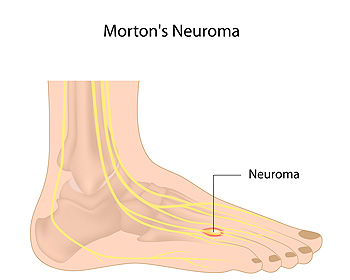 A Morton’s neuroma is usually indicated by symptoms that target a pinched nerve between the third and fourth toes. The pain from this ailment is located in the ball of the foot, and it may cause difficulty in walking. Morton’s neuroma may develop due to wearing shoes that do not have enough room for the toes to move freely in or medical conditions consisting of flat feet or high arches. Many people choose to have an MRI performed, which can effectively diagnose Morton’s neuroma. Mild relief may be found when flat shoes are worn that can provide adequate room, and many styles have the cushioning that is needed to help accomplish daily activities. If you have pain in this part of your foot, please consult with a podiatrist who can treat this condition.
A Morton’s neuroma is usually indicated by symptoms that target a pinched nerve between the third and fourth toes. The pain from this ailment is located in the ball of the foot, and it may cause difficulty in walking. Morton’s neuroma may develop due to wearing shoes that do not have enough room for the toes to move freely in or medical conditions consisting of flat feet or high arches. Many people choose to have an MRI performed, which can effectively diagnose Morton’s neuroma. Mild relief may be found when flat shoes are worn that can provide adequate room, and many styles have the cushioning that is needed to help accomplish daily activities. If you have pain in this part of your foot, please consult with a podiatrist who can treat this condition.
Morton’s neuroma is a very uncomfortable condition to live with. If you think you have Morton’s neuroma, contact one of our podiatrists of James Kutchback, DPM, CWS-P. Our doctors will attend to all of your foot care needs and answer any of your related questions.
Morton’s Neuroma
Morton's neuroma is a painful foot condition that commonly affects the areas between the second and third or third and fourth toe, although other areas of the foot are also susceptible. Morton’s neuroma is caused by an inflamed nerve in the foot that is being squeezed and aggravated by surrounding bones.
What Increases the Chances of Having Morton’s Neuroma?
- Ill-fitting high heels or shoes that add pressure to the toe or foot
- Jogging, running or any sport that involves constant impact to the foot
- Flat feet, bunions, and any other foot deformities
Morton’s neuroma is a very treatable condition. Orthotics and shoe inserts can often be used to alleviate the pain on the forefront of the feet. In more severe cases, corticosteroids can also be prescribed. In order to figure out the best treatment for your neuroma, it’s recommended to seek the care of a podiatrist who can diagnose your condition and provide different treatment options.
If you have any questions, please feel free to contact our offices located in The Woodlands and Woodville, TX . We offer the newest diagnostic and treatment technologies for all your foot care needs.






